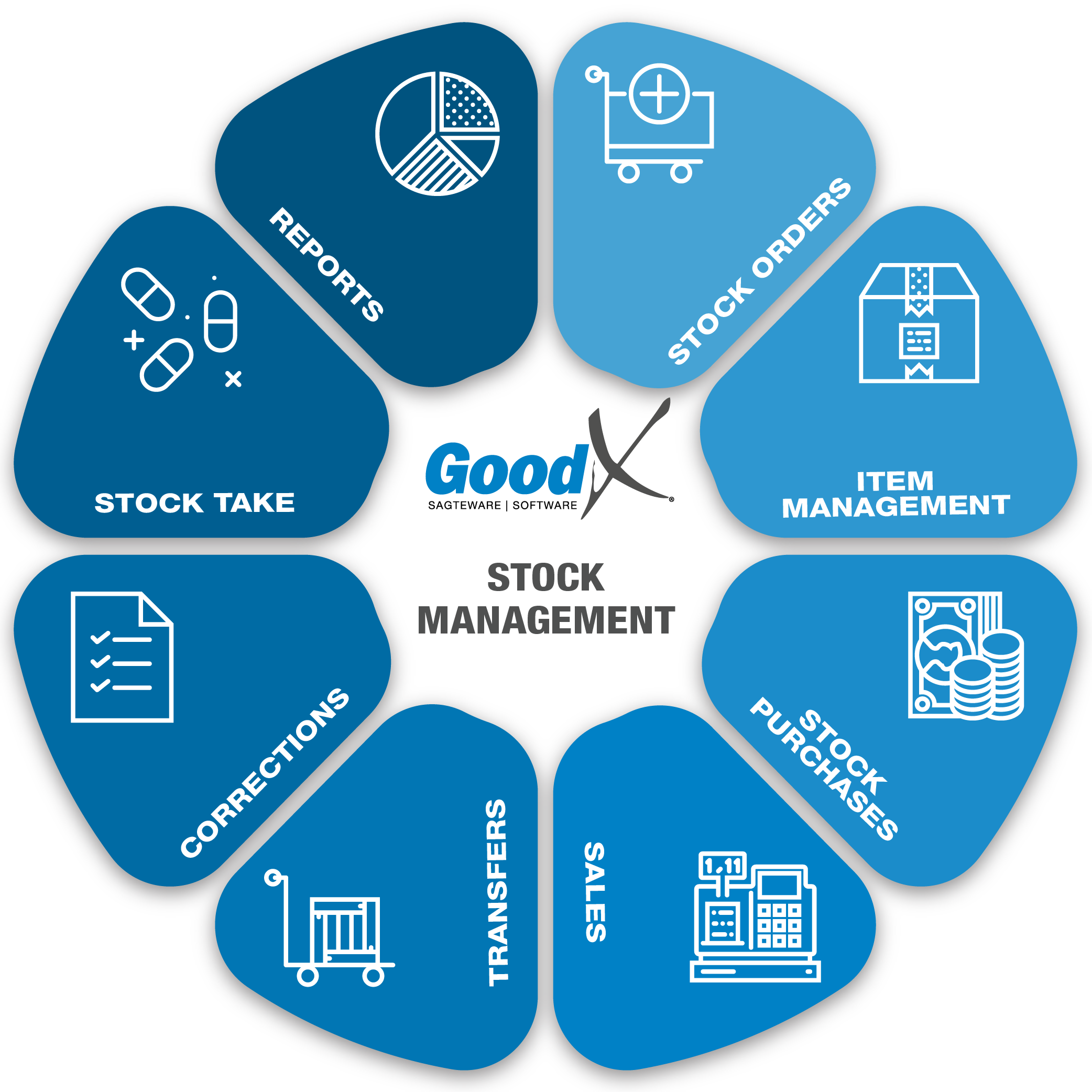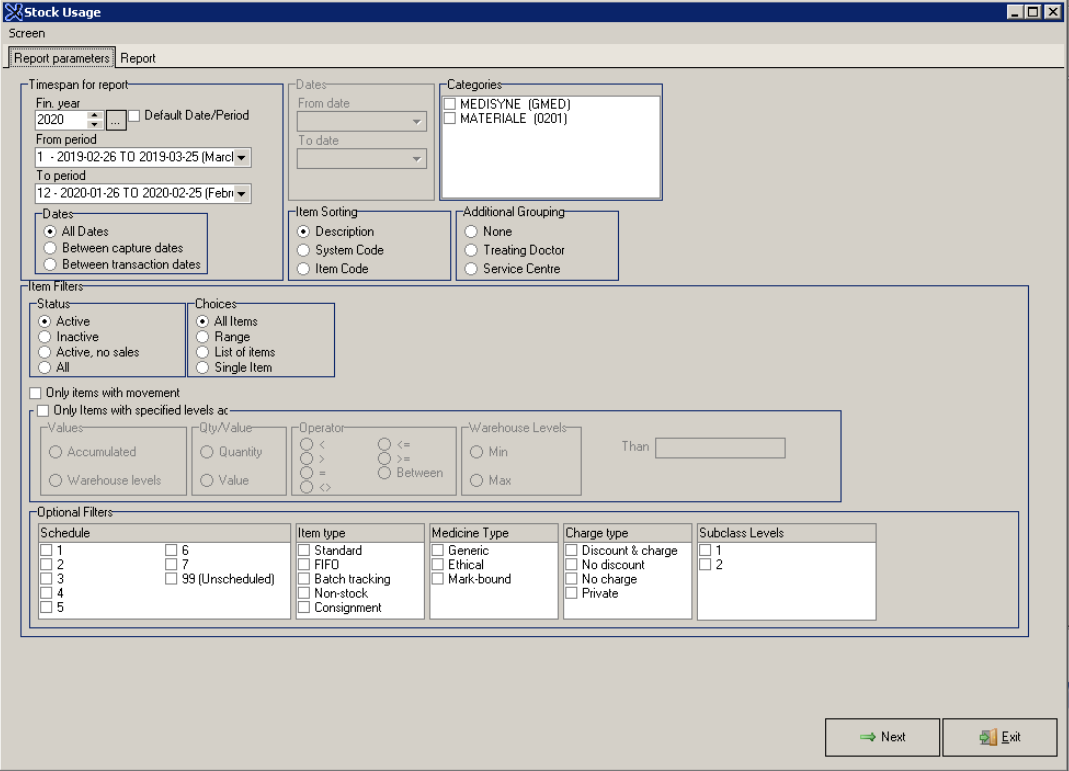Best Practice Guidelines: Stock Management

Copyright © 2020 GoodX Software. All rights reserved.
GoodX online Learning Centre
learning.goodx.co.za
10. Reports
10.5. Stock Usage Report

The Stock Usage report will show the total amount of stock used for a specified period. The usages can be grouped per medical practitioner/service centre. Grouping by practitioner/service centre will highlight which practitioners/service centres are making the biggest losses/profits on their stock. The main function of this report is to indicate how many items were used during a certain period and where a loss or profit was made on items.
This report can also be used to point out slow-moving stock items by drawing the report for a 6 month period and filtering on Units sold with a Zero quantity.
The following information can be found on this report:
- System and Item Code
- Item Description
- Units on Hand
- Units and Packs Sold
- Packsize
- Sales Value and AVG Sales Unit price
- Cost of Sales and Cost per Unit
- Gross Profit (%) and Gross Profit (R)
- Schedule
- Sales Price
- Column Totals
EXAMPLE OF A STOCK USAGE REPORT

Stock Usage report setup and explanations
Report Parameters

1. Dates on All Dates - Timespan for the report:
- Fin. year - The Financial year the information will be based on.
- ... button - Default date controls to the current date (From and To Periods).
- Tick box Default Date/Period - Will always use the current date and period when the report is drawn.
- From period - The financial period where the movement must start (must include from).
- To period - The financial period where the movement must end (must include still).
2. Dates on "Between capture dates" and "Between transaction dates" - Dates from and to (Timespan for the reports will be greyed out and the Dates field will be editable):

- From date - from the day the transactions must start and must be included.
- To date - up to the last day that must be included.
- Capture dates - When the transaction was done on the computer.
- Transaction dates - When the transaction actually happened in real life.
3. Categories:
- Categories - There are different categories of stock depending on the company or practice speciality.
- Medical practices’ stock will be divided into two categories - Medicine and Materials:
- Medicine (GMED) - All the medicine will be under this category, and
- Material (0201) - All the consumables and injectables will be under this category.
- Hospital stock (GMED) - The hospitals will only have one category where all the items will fall under this one category.
- There can be more categories depending on the practice, for example, Stationary, Groceries, Front Shop, etc.
4. Warehouses:
- This setting is only applicable for practice with a multiple warehouse setup
- All - Transactions will be grouped per Warehouse
- Choose - The Warehouse can be chosen to see the transactions inside that Warehouse or Multiple Warehouses
5. Item Sorting:
- Item sorting is done according to the different items that are included in the report
- The sorting of the information in the report can be according to Description, System Code or Item Code
- The sorting can also be adjusted in the report with the filters on the columns
6. Transaction Sorting:
- Transaction sorting is done on the detail
- The transaction can be sorted according to Transaction Type, Capture Date or Transaction Date
- The sorting can also be adjusted in the report with the filters on the columns
7. Display Transaction Types:
- The transaction types should be included in the movement report
- Purchases - All the stock that was bought (purchased) from the Suppliers, and Credit notes done on the Suppliers
- Sales - All stock that was sold to the patients or used on the patients and the Credit notes that were processed on the Debtors accounts
- Adjustments - All the adjustments that were done on the items, Broken stock, expired stock, Lost stock and Stock Takes
- Transfers - All the transfers that were done between the Warehouses, moved from one Warehouse to another.
8. Item Filters:
Applying item filters will only allow the selected information to be available - unique indicators on items.
8.1. Status:
- “Active†items - Only the active items and not the inactive items.
- “Inactive†Items - Only the inactive items and not the active items.
- “Active, no sales†- Only the items that are marked as active, no sales.
- All items - This will include all the items on the list; active, inactive as well as active, no sales.
8.2. Choices:
- All Items - Will include all the items that have the markers indicated on the report setup.
- A Range of Items - All items from a number to a number, for example, from item code GMED20 to item code GMED29, all the item codes between these numbers will be included with the markers that were set up.
- List of Items - Will gives the choice to indicate a list of items where the list can be imported from a notepad or typed into the list function.
- Single Item - Only one item that must be chosen will display with the markers as set up on the report.
9. Only items with movement:
- Only the items with movement will be displayed in the report if the item has transactions on or between the dates of the report settings.
10. Show opening and closing balances:
- Will show the opening and the closing balances of the items for the period that was chosen.
- Opening balance is the value and quantity of the previous period’s closing balance.
- The closing balance is the value and quantity at the end of the current period and will be the opening balance for the next period.
11. Only items with specified levels: Values:
- Warehouse levels: The option will be available to choose from which quantity the items must have before displaying the items in that warehouse.
12. Only items with specified levels: Qty/Value:
- Quantity: Specified level on the total quantity of the stock items.
- Value: Specified total Rand value of the stock items.
13. Only items with specified levels: Operator:
- > Bigger than
- < Smaller than
- = equals to
- <> smaller or bigger but not equal to
- >= Bigger than and equal to
- <= Smaller than and equal to
- Between - between two types or numbers
- The system will ask the quantity or value where this must be applied to.
14. Only items with specified levels: Warehouse Levels:
- Min - Minimum quantity stock levels.
- Max - Maximum quantity stock levels.
- The system will ask which minimum or maximum values must be included in the report.
15. Optional Filters: Schedule:
- 1 to 7 - The items are classified with a schedule according to the Health Council.
- 99 (Unscheduled) - Is unscheduled stock items, normally non-stock and some consumables.
- A register must be kept on Schedule 5, 6 and 7.
- Multiple schedules can be chosen.
- If none is chosen, all the schedules will be included in the report.
16. Optional Filters: Item Type:
- The item is classified with the type, please refer to the Glossary for the explanations on the terms of the stock types.
- One or multiple types can be chosen that must be included in the report.
- If none is ticked, all the types will be displayed in the report.
- The different types are Standard, FIFO, Batch tracking, Non-Stock and Consignment.
17. Optional Filters: Medicine Type:
- The Medicine type is not applicable any more, this filter will be taken out in the future.
18. Optional Filters: Charge type:
- The charge type will apply certain rules on the item when it comes to billing and capturing the purchases.
- Please refer to the Glossary for an explanation of the different Charge types.
- The different charge types are Discounted & charge, No discount, No charge and Private.
19. Optional Filters: Subclass Levels
- The different subclass levels that are linked to the item.
- The report can be drawn on one or multiple subclasses if the practice is using subclasses.
- If none is ticked the system will not indicate the subclass.
Functions that will be used in GoodX
- Stock Usage Report (Reports > Stock Usage Report > Choose profile or Edit the blank profile to choose your own settings)